Building with Structural Brick
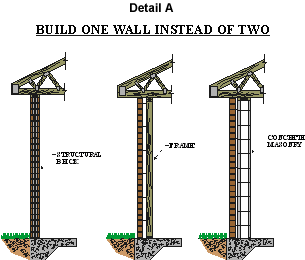 Why Build Two Walls When You Only Need One?
Why Build Two Walls When You Only Need One?
Most conventional brick veneer construction consists of a load bearing wall of either wood studs, cold-formed steel studs, or concrete masonry units with the brick units as a finished wall. In a sense, the brick is serving as little more than 4" of paint. In a structural brick wall system, however, the brick serves as both a structural system and the exterior finish facing (see Detail A). Using brick as both the building's exterior finish and its structure capitalizes on the brick masonry's strength, attractive appearance, and other inherent values.
Designed as reinforced load-bearing units rather than just a facing material, structural brick provides a different look, an alternative method of construction and a number of benefits over traditional building methods. Structural brick buildings can be more energy-efficient and are more sound-resistant than buildings of traditional construction. The use of structural brick wall systems also provides for higher resistance to wind and seismic forces.
Structural brick homes in the Seattle, Washington area were found to have performed extremely well in the recent Nisqually earthquake. The elimination of costly wood framing and the need to deal with fluctuating lumber prices is yet another benefit of using structural brick.
Brick gives a home permanence and beauty. Brick homes have lower maintenance costs and often lower insurance rates because of their fire resistance characteristics. For these reasons structural brick homes often have higher resale values and greater curb appeal than homes constructed with traditional methods or other siding materials. Structural brick systems offer all of these advantages, and can still be cost-competitive with most siding materials.
As recently reported by the Daily Herald in suburban Chicago, Sean Flaherty, a mason and owner of C.S. Flaherty Contractors completed a structural brick home. The home is located in West Chicago, Illinois in a subdivision called Kresswood Trails. Although Flaherty is a mason by trade, his role on this project was also that of a general contractor.
"Even though this was my first project I didn't really have any problems during construction. I really like the system and I plan to continue to build many more homes with structural brick. In fact, I'm now in the process of putting together my next project which will be my own home," said Flaherty.
Flaherty's 4-bedroom 2500 sq. ft. home is priced at $319,000. Flaherty estimates the same home with siding would cost $306,000, with traditional brick veneer, it would have cost $328,000, and the same home constructed with concrete masonry units (CMU's) and brick veneer would have cost $337,000.
Energy Considerations
Because of their construction features and thermal mass properties structural brick homes are considerably more energy efficient than comparably insulated vinyl or wood sided homes.
When rigid foam board insulation is used the configuration of a structural brick building allows the contractor to install a continuous uninterrupted skin of insulation against the exterior wall of the building. This is unlike conventional frame construction where the insulation is interrupted by framing members, electrical conduits, and piping. There is no thermal bridging when this system is used.
With conventional wood-framed veneer construction you have two building materials which act in very different ways. Wood will undergo shrinkage over time while brick will generally expand due to moisture expansion. These opposing movements can result in gaps and cracking in caulking around doors and windows which become points of air infiltration and heat lose. With a structural brick system you only have one "single skin" so your wall, doors, and windows all move together and you don't have this problem.
In light of the current energy issues and rising natural gas prices in the United States these benefits will certainly become even more significant.
Design Considerations
The masonry standard used for the design and construction requirements of structural brick systems is ACI530-99/ASCE 5-99/TMS 402-99, "Building Code Requirements for Masonry Structures". This standard is commonly referred to as the "MSJC Code" (Masonry Standards Joint Committee).
Reinforced load bearing brick buildings are acceptable by all of the current model building codes (UBC, BOCA, SBC, and CABO) as well as the new International Residential Code for One and Two Family Dwellings IRC 2000 when designed in accordance with Engineered provisions of the MSJC Code.
Load bearing brick buildings with walls equal to or greater than 6 inches in nominal thickness may be designed in accordance with the empirical provisions of the MSJC Code. However, empirical provisions can typically not be used for buildings greater than one story in height or in high wind or seismic areas. In these instances engineered design would be required.
Consideration of the building layout during the design stage can help to simplify the construction. Building dimensions (wall lengths and door and window openings) should be laid out in increments of the brick units width whenever possible. This helps reduce cutting of brick units and makes the work easier for the mason.
Brick manufacturers can also help contractors and design professionals with their structural brick projects. "Our commitment to structural brick goes beyond just making the brick. We also provide engineering support, a structural design manual, privacy wall designs, house plan ideas, detailed technical literature, and computer design software for qualified professionals," said Bob Propes, Director of Promotions and National Accounts at General Shale Brick.
Selection of Masonry Units
Reinforced structural brick construction utilizes hollow clay units, which are manufactured in accordance with the requirements of ASTM C652, Specification for Hollow Brick. These units are manufactured with cells which can accommodate vertical reinforcement and grout. Bond beam units are also available, which are used for supporting ledger boards at floor connections and at the top of a wall for support of the sole plate and roof truss system. Bond beams are also used to build reinforced beams or lintels over window and door openings. Reinforced masonry beam lintels with nominal amounts of reinforcement steel can easily span 18-foot garage door openings without the use of a steel angle.
There are a variety of sizes of structural brick units manufactured today. Hollow units are available in nominal widths of 4 inches, 5 inches, 6 inches, and 8 inches. For residential and light commercial construction, the 5 inch and 6 inch nominal units are the most common. While 8 inch units are generally used for larger scale commercial projects. When selecting a unit you should consider both the structural requirements as well as the aesthetic features of the unit when placed in the wall.
"When we developed our SuprKing™ structural brick, we wanted a unit that could handle high wind loads and earthquake forces for residential and light commercial projects, but we also wanted a unit that had a more pleasing scale than some of the larger structural units in use. This is why we chose the 9 5/8"(length) x 2 3/4"(height) x 4 5/8"(width) size of our SuprKing™ unit," said Mark Kinser Vice-President Corporate Development and Marketing at General Shale Brick in Johnson City, Tennessee. "We also produce the special shapes such as bond beams and special quoin units that I feel are essential for successful structural brick projects," says Kinser.
Structural Brick Applications
Effective structural brick applications can take many shapes. Tom Bishop of Berry Enterprises in Chilhowie, Virginia has been using structural brick in his masonry operations since 1995. Bishop's masonry crews have completed a number of successful structural brick projects including homes, privacy walls, an automobile service station, two building material stores, a vehicle maintenance building, a building supply warehouse, a multi-use facility for a church, and a farm utility barn.
Engineers Like Structural Brick Construction
Todd Dailey, a professional engineer and owner of Dailey Engineering, a firm which specializes in masonry consulting and school facility design in Onsted, Michigan, chose structural brick for his own home. "A major factor was professional interest. Being involved in building design, it was automatic that our house would be of some sort of masonry for all of the advantages it brings (durability, appearance, low maintenance, etc.). I finally decided on SuprKing™ because I liked the idea of putting the structural strength of brick to use instead of just using it as cladding", says Dailey. " When we first moved into the house our family was amazed at how little outside sound could be heard. We live on a lake, and high winds often develop over the open water. About the only time we would hear anything is when the wind speeds would get high enough to rattle the roof shingles." Dailey, who lives in Michigan with cold winter conditions has also been very impressed with the energy efficiency of his home. "My annual gas bills average less than $900 for our house, which includes heat, hot water, and for heat to melt snows and ice off of my driveway. I see the rigid insulation, with taped joints and no thermal bridges, as more superior than conventional studs/batt insulation." Dailey's home has 3500-sq. ft. of living space.
Hal W. Barrineau, owner of H.W. Barrineau and Associates, Inc. in Ocala, Florida also selected structural brick for their new 5,600 square feet office building in Oakhurst.
Professional Park. Ocala, Florida has long been known as "Brick City" because of the numerous buildings and city streets that have been constructed with brick. Mr. Barrineau said, "I was looking for that visual appeal that would provide the professional office atmosphere, while keeping with the long standing use of brick in Ocala. I also hired David Pillsbury, Architectural Designer, of Lines of Ocala, Inc. to help me obtain the desired look."
Additionally, as the engineer responsible for the structural design of the building, Mr. Barrineau was interested in the savings provided by the use of structural brick, which allowed the elimination of wood-framed, load bearing perimeter walls. "As the owner, I realized a savings of approximately $8,000."
"The structure has a 6:12 and 3:12 roof pitch and is in a 100 mph wind zone which presented a few special loading conditions from the roof system. The building constructed by Fabian Construction, Inc. of Ocala, has turned out to be the showcase of the Professional Park," Barrineau said.
Structural Brick is Not Just for Houses
Structural brick units also make an excellent choice for privacy walls, entrance walls, and sound barrier walls. Again, why lay two or three wythes of brick when you need only one? Single-wythe, structural brick walls can take the place of double-wythe bonded walls or concrete masonry unit (CMU) walls faced on both sides with brick veneer.
Many brick units in standard production today, including wire-cut, and through body units provide a very pleasing look on both sides of the wall. Some manufacturers also produce units which are color-coated on both sides making a single-wythe wall a very attractive and very practical design.
Structural brick walls can be built using one of two different construction methods, which are used in a variety of residential and commercial applications: (1) Cantilever walls ? these simple, cantilever-type footing, supported walls, are more traditional and are typically used in residential construction for entrance walls, privacy walls, and garden walls; and (2) Pier and panel type walls ? these are often preferred on commercial projects and by state transportation officials because a continuous footing is not required, which can result in significant, concrete cost savings (see Detail B). Pier and panel walls also provide the option of using panelization systems.
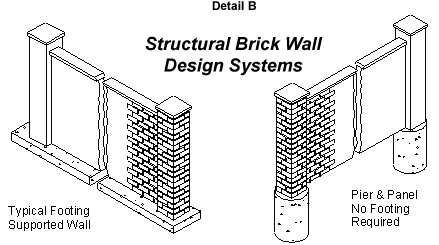
Utility structures such as barns, garages, storage facilities, warehouses, and masonry infill on metal buildings are also excellent applications for structural brick systems. If you have an unheated building or a building not requiring air conditioning, you should definitely consider a structural brick system. In these applications, both the inside and outside mortar joints are tooled so that the structural brick serves as the load bearing wall, exterior finish, and interior finish wall.
A Guide to Building with Structural Brick
With a structural brick system, masonry is the primary structural element and masonry work begins as soon as the foundation is complete. With conventional construction, brick delivery to the site is not required until a significant amount of work, including all of the framing, is complete. Because of this, the contractor should ensure that the early delivery of brick is scheduled for structural brick projects.
I. Initial Layout of Brick
The first step in brick work is to layout the first course of brick and identify the location of reinforced cells. Holes are drilled in the foundation at these locations, which will later be used to anchor vertical reinforcing using a structural epoxy. A piece of duct tape can be used to keep the holes clean as masonry work proceeds. Conventional dowels can also set foundation when the concrete is poured, but the use of an epoxy system eliminates any problems caused by mislocation of dowels.
II. Keeping The Cells Clean
The brick units are then laid like any standard brick, except the mason should ensure that the cells, which will be reinforced, are kept clean. This can be accomplished by the use of a sponge, which is pulled up through the cell as the work proceeds, preventing mortar droppings from clogging the cell.
III. Door and Window Lintels
Lintels for door and window openings can be temporarily supported with framing lumber and laid in place (see Detail C). As an alternative method, lintels can also be constructed on the ground in a vertical position. After the mortar and grout has cured (3 days is generally sufficient), the assembled lintel units can be lifted in place.
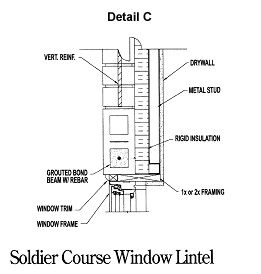
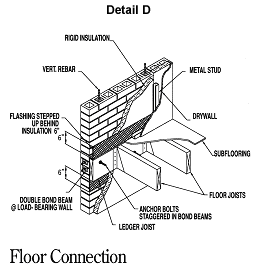
IV. Mortar and Grout
For reinforced structural brick systems, the use of type S mortar is recommended. Mortar should meet the requirements of ASTM C270, Specification for Mortar for Unit Masonry. Grout used in structural brick systems should meet the requirements of ASTM C476, Specification for Grout for Unit Masonry. To facilitate the grouting of smaller cells, a fine grout mix is generally used for residential and light commercial construction. On smaller scale projects most masons mix the grout in 5-gallon, plastic buckets and pour the grout in the cells with the aide of a sheet metal funnel, which can be easily fabricated by a metal shop. On larger projects, redi-mix pumped systems are often used. The grout mix should be fluid enough to fill all voids, but not separate into its constituents. A slump of 10 to11 inches is generally recommended. A typical grout mix for residential construction would consist of 1 bag (94 lb.) of Type 1 portland cement, 300 lbs. of damp concrete sand, and 2 ? - 3 ? gallons of water adjusted to produce the desired slump.
V. Floor Connection
For multi-story construction, the ledger board support and floor-framing system should be installed before the additional story construction proceeds (see Detail D). This is important because the floor diaphragm acts as lateral brace for the wall. If this is not done, the contractor should ensure the wall is adequately braced during construction.
VI. Roof Connection
The top course of brick consists of a bond beam unit, which acts as a tie for the structural wall system (see Detail E). The roof trusses can then be set and roofing material installed. This allows the rest of the construction to be completed "in the dry", protected from the elements.
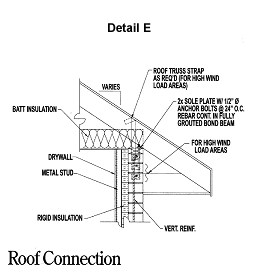
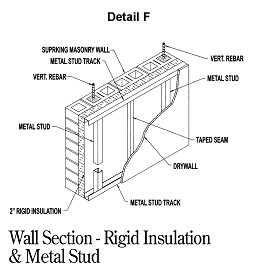
VII. Interior Wall Finishes
Because interior wall framing is not typically required structurally, the interior wall layout can be moved to suit the needs of the owners or tenant. This "open floor" advantage also makes it possible for a developer to complete a shell, then allow a buyer to choose a floor framing option after the shell has been completed.
VIII. Interior Wall Finishes
Any type of interior wall finish can be used with a structural brick system including simple furring strips nailed directly to the brick, hat channels, or light gage non-load bearing metal studs. For unheated utility structures such as garages and barns, an unfinished wall with the joints tooled on both sides is all that is required. The preference with contractors for interior wall system finishes seems to vary regionally across the country. For example, furring strips seem to be most popular in the South, including Florida, while metal studs are becoming more popular in the North.
From an overall performance standpoint, including cost, energy considerations, and appearance of the finished wall, metal studs with rigid foam insulation perform very well (see Detail F) Some finish carpenters have complained about the use of metal studs because they feel it causes a problem with base trim installation since you are unable to nail into the metal base. Contractors have solved this problem by first installing a wood 2x member to the floor to provide a nailing base for the trim.
In Conslusion
Because of its inherent values, aside from its strength, permanence and beauty, the use of structural brick as an alternative building method is steadily gaining in popularity among mason contractors, engineers and industry professionals alike. The benefits offered over traditional building methods makes the choice to build with structural brick an easy one. Bill Kjorlien, Executive Director of the Southern Brick Institute and a mason by trade says, "Clay units offer a significant benefit over concrete units. The compression strength of clay units can be 4 to 5 times higher than concrete units. This means you require less material, which can be a real benefit to the mason contractor." So building with structural brick masonry, although it is very similar to construction with load bearing, concrete masonry units, this alternative method not only kills two birds with one stone - by serving as both the building's exterior and its structure - it leaves you with a much better-looking wall. Furthermore, its energy-efficiency, its high resistance to sound, wind and seismic forces, its low maintenance costs and high resale value, and the overall cost savings makes structural brick the "up and coming" building material of choice within the masonry construction industry today.
About the Author
Jim Bryja P.E., S.E. is the Manager of Engineering Services at General Shale.


















